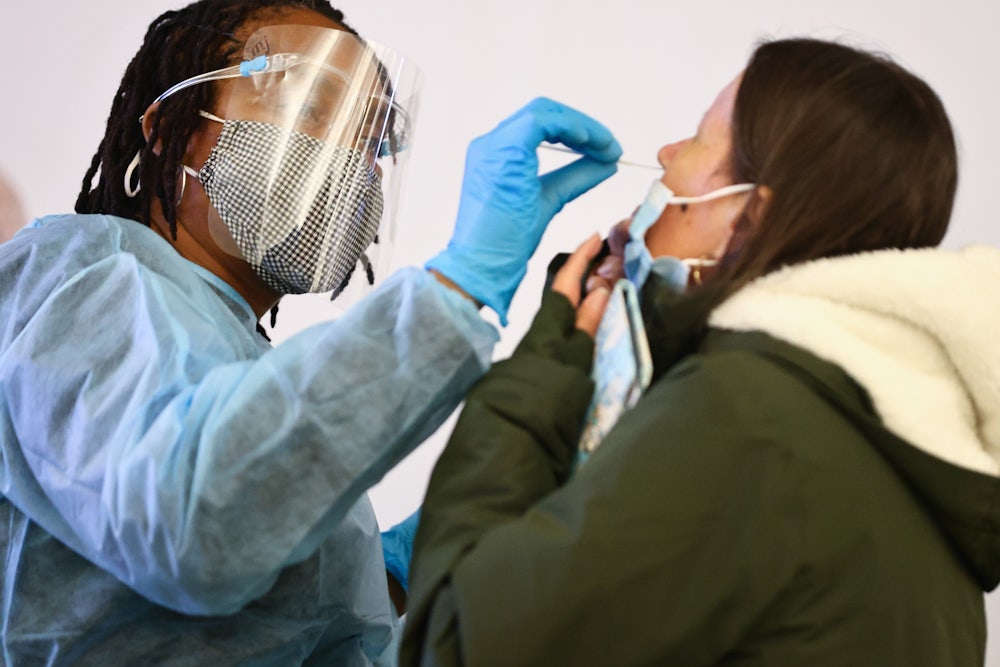As Covid-19 cases in the United States soar to record highs, many are pinning their hopes on the omicron variant, however contagious, being less severe than the delta variant that came before it. Perhaps, some health care experts hope, surviving omicron could even provide some immunity against other variants. It’s a glimmer of hope in a dark time.
The problem is, it’s too soon to know how severe omicron is—and individual symptoms aren’t always the best way to talk about severity. By taking preventative measures off the table and prioritizing the economy even if it means sending people back to work and school with active Covid cases, policymakers betting on the mildness of this virus could risk toppling the health care system as we know it—and allow more death and disability to rise throughout the country.
We have more questions than answers at this point about the omicron variant, which was only identified six weeks ago: How mild is it really, does it mean we’re close to emerging from this phase of the pandemic, and what does it signal for future variants?
Here’s the evidence for the “omicron is milder” thesis: According to experiments with mice and hamsters, the variant doesn’t attack the lungs as aggressively as delta did. “The omicron variant, so far, appears to be less severe than the delta,” Dr. Anthony Fauci, chief medical adviser to the White House, said on January 5. But he added that assessment is based on “multiple sources of now-preliminary data,” and he cautioned “we really do need more definitive assessment of severity with longer-term follow-up.”
It’s possible omicron is more mild among people, Dr. David Martinez, a viral immunologist at the University of North Carolina, Chapel Hill, told me. “There’s a lot of clues that suggest that it is, but I just think we have to think about the nuances and the limitations of, for example, the model systems.” After all, people are neither mice nor hamsters, and animals are an imperfect proxy for exactly how a virus spreads through the human body.
But it’s also possible that the virus, as it rips through millions of people, is picking up mutations that make it more efficient in humans than in animals—which means making predictions based on studies in animals could become even more fraught. “As the virus continues to evolve, are the animal models going to still faithfully recapitulate what has happened in humans?” Martinez wonders. “If the animal data potentially looks different, then you just have to think about why it could look different.”
Until now, other countries’ experiences with omicron have also been comforting. Waves in South Africa and Europe, for instance, began falling nearly as rapidly as they rose, with much lower hospitalization rates than previous surges. But the U.S. is showing signs of much worse outcomes, with hospitalizations rising quickly in the wake of surging cases—possibly because of an older, sicker population with lower immunity. And vaccination can’t entirely make up for vulnerabilities.*
Severity is also relative. Omicron may be less severe than delta—but delta was more severe than previous variants, recent research shows. It’s possible, for someone who is not vaccinated or hasn’t encountered Covid before, that omicron will be just as severe as the virus that wrought devastation throughout 2020. “While omicron does appear to be less severe compared to delta, especially in those vaccinated, it does not mean it should be categorized as ‘mild,’” Dr. Tedros Adhanom Ghebreyesus, director-general of the World Health Organization, warned on Thursday.
And even if it is a milder version of the virus, its high transmissibility cancels out those gains. “If you keep doing this every day—with infections, they can at some points go exponential,” Martinez said. “As those infections skyrocket, what is this going to do to our already-strained health care system that appears to be hanging on a thread?”
The best way to judge severity among people is still hospitalizations and deaths—but that’s becoming increasingly difficult to measure. “We currently have a health care system that is actively collapsing, if not already collapsed, in many spaces,” Dr. Rae Walker, associate professor and Ph.D. program director at the Elaine Marieb College of Nursing at the University of Massachusetts Amherst, told me. “Almost every health system is operating on fumes.”
“People keep talking about how hospitalizations are a lagging indicator of the severity of illness, right?” Walker said. “We’ve seen all these case counts spiking, but you know, ‘What we really need to look for is the number of hospitalizations to get a sense of how severe this really is.’ But the reality is, we’ve already hit the ceiling on many of these graphs.” Walker’s local hospitals are already 20 or 30 percent over capacity.
It’s not just a lack of hospital beds or ventilators: It’s having enough staff to care for everyone as the entire country lights up in bright red with cases and hospitalizations. Supply chain woes are hitting hospitals, as well, with masks and other protective gear once again running low. “One hospital had run out of saline flushes. Saline flushes are the most basic tool that you need to do I.V. therapy. That’s like the simplest technology that we have in health care,” Walker said, incredulous. “It’s human expertise and laborers, but it’s also the actual supplies themselves. And both of those things right now are at such critically low levels that even without omicron, I think we would be incredibly stressed.”
Across the country, hospitals are warning against coming to the emergency department unless it’s a true emergency, as patients wait for hours or days to be seen. Overflowing hospitals send patients hundreds of miles away and divert ambulances.
That can throw hospitalization numbers for omicron off: “They can’t even count the number of admissions because those people are not able to even arrive at the steps of the E.D.,” Walker said. “What I worry is, as people wait to see this idea of a further spike in hospitalizations or ICU admissions, is that those numbers may not play out because we’ve already hit the top of the graph,” exceeding hospital capacity, they clarified.
At the same time, the definition for what counts as a case worthy of hospitalization is changing, Walker said. When hospitals are overloaded, the sickest patients are prioritized, which means other patients, who would normally be admitted quickly, can spend days waiting in the emergency department—a practice called “boarding” that can further strain capacity and affect patients’ outcomes.
All this adds up to a troubling realization. Relying on hospitalization data is like relying on test data early in the pandemic: It’s an incomplete picture due to a stunning lack of capacity. “I am distressed every time I see that word, ‘mild,’ because it feels like part of a narrative designed to tell us to just keep our heads down and keep on keeping on,” Walker said.
And the pandemic is causing other pressures on this system, even if the diagnosis isn’t Covid: “We’re now getting to the point where there has been so much deferred care for so long, and so little capacity to make up for that, that we’re going to see a wave of acute health problem exacerbations that may require a higher level of care, such as hospitalization,” Walker said.
The notion that omicron is “mild” might be masking another troubling phenomenon: that omicron is in fact attacking the body in a different, subtler way—one that could still result in very severe outcomes. “It’s making people really sick in a different way,” Dr. Craig Spencer, an emergency physician in New York, tweeted recently, with omicron seeming to “topple a delicate balance of an underlying illness.” Covid, in other words, could be tipping fragile patients with chronic illness, like heart disease or diabetes, into distress, said Dr. Michael Warner, a physician in Toronto—with the result that many hospitalizations may still be driven by Covid, even if it’s not the primary diagnosis.
Any discussion of disease severity must include long Covid as well, which can develop after mild or even asymptomatic cases of Covid. Research on causes and treatments for long Covid is still ongoing. “Even if it turns out to be a milder disease, which would be welcome, we still have to be cautious for it,” Martinez said. “We can’t just let it run free or burn through the population, because it could still have those devastating effects.”
The bottom line is that omicron may still pose a serious threat, and not only to the unvaccinated. It’s dangerous for vaccinated people who will get serious breakthrough infections because they are immune-compromised, older than 65, or simply unlucky. And it’s dangerous for absolutely anyone who might need to use the hospital in the next month.
One thing we do know: Omicron won’t be the last variant. It’s impossible to know if future versions of the virus will become milder or more severe. Omicron itself was a surprise, arising from a version of the virus common in summer 2020. The next one could evolve from omicron, becoming more or less severe—or it could also come out of nowhere. But with millions of cases a week in the U.S. alone, each offering millions of chances to evolve, all we know is that there will be a next one, Martinez said. “What we don’t know is, how different will a future variant be?”
Looking to the future can be a grim exercise—particularly when there is so much we still don’t know. But “there will be a day that the pandemic will end. This won’t be forever, even though it seems like it will,” Martinez reminded me. The turning point will likely come “once our health care system isn’t as strained as it is right now,” he said. When hospitalizations once again decline, when effective treatments are more widely available, when health workers have a moment to breathe, the future will look brighter.
But it’s up to us to make that happen. Counting on a variant evolving to be milder, without taking any other critical measures to prepare and respond, would be asking the very virus that got us into this problem to get us out of it.
*This article has been corrected to remove line that erroneously interpreted a U.K. statistic about hospitalizations among the elderly who have received boosters.










